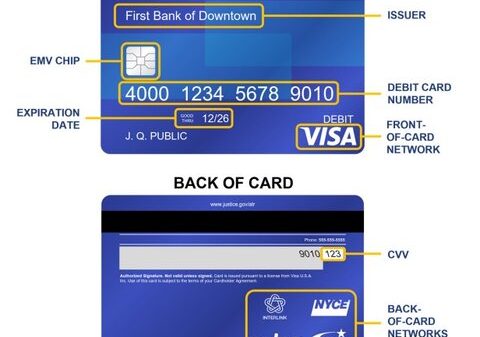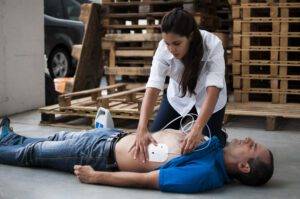A defibrillator, particularly an automated external defibrillator (AED), is a life-saving device used in emergencies involving cardiac arrest. When the heart suddenly stops beating, swift action with an AED can make the difference between life and death.
These devices are designed to be user-friendly, enabling both trained and untrained bystanders to provide immediate assistance. The AED works by analysing the heart’s rhythm and, if necessary, delivering an electrical shock, or ‘defibrillation’, to help the heart resume an effective rhythm.
The widespread availability of AEDs in public places such as schools, gyms, and airports increases the chances of survival after cardiac arrest. When deploying an AED, the operator is guided through the process by clear, step-by-step audio and visual cues provided by the machine. This ensures that even individuals without medical training can use the device correctly. The design of these devices takes into account the critical nature of the situation, minimizing the risk of a wrong operation.
If someone experiences cardiac arrest, quick intervention with an AED, alongside cardiopulmonary resuscitation (CPR), significantly improves their prospects for recovery. The instructions typically include placing one pad on the upper right side of the chest below the collarbone and the other on the left side under the armpit. It’s crucial to stand clear during the analysis phase and when a shock is administered to avoid interference with the process. Proper training of an AED could save a life, making knowledge of its operation an invaluable tool in emergency situations.
Recognising a Cardiac Arrest
In the critical moments of a cardiac arrest, identifying the signs and swiftly responding can greatly increase the chances of survival. It is vital to assess the patient’s responsiveness and heart rhythm, and call for emergency assistance immediately.
Assessing the Patient
When one suspects a cardiac arrest, the first step is to check if the patient is responsive. Look for these specific signs:
Unresponsiveness: Shake gently and shout to see if there’s any reaction.
Abnormal breathing: Listen and feel for breathing, noting any gasping which is not normal breathing.
Should the individual display no signs of responsiveness or normal breathing, they may be experiencing a cardiac arrest.
Calling for Help
Once cardiac arrest is suspected, calling 999 immediately is crucial. One must:
Clearly state that the patient is unresponsive and not breathing.
Follow the instructions given by the emergency operator.
If instructed and able, send someone else to retrieve a public access defibrillator.
Connecting with emergency services quickly ensures that professional guidance will be available while waiting for their arrival.
Accessing the Defibrillator
In a critical situation requiring a defibrillator, quickly finding and accessing the device is paramount. Fast response can greatly increase the chances of survival for a person experiencing sudden cardiac arrest.
Locating a Defibrillator
Public access defibrillators (PADs) are typically situated in areas with high foot traffic to ensure broad availability during emergencies. Locations commonly include shopping centres, train stations, and community hubs. An individual can locate the nearest defibrillator by using dedicated online resources like the British Heart Foundation’s Defib Finder.
Public Access Availability
PADs are designed for use by the general public and do not require medical training, ensuring that they are accessible to anyone. Signs often clearly mark their location. They are frequently found in secure cabinets which may require a code to open. This code is usually provided by the emergency services operator when one dials 999. Community awareness campaigns have increased public knowledge pertaining to the locations of PADs in shops and throughout the community, reinforcing the network of potentially life-saving equipment.
Preparing to Use the AED
Prior to using an Automated External Defibrillator (AED), it’s crucial for one to ensure the safety of the scene and properly prepare the patient to increase the efficacy of the life-saving procedure.
Assessing the Scene Safety
Before administering any first aid with an AED, one must assess the scene to confirm that it is safe to approach the patient. This involves looking out for any potential hazards such as fire, traffic, or electrical wires that could pose a threat to both the rescuer and the patient. If the environment is dangerous, it needs to be made safe, or emergency services should be contacted to handle the situation.
Preparing the Patient
Once the scene is deemed safe, attention must turn to the patient. If the patient is unresponsive, not breathing, or only gasping, one should immediately commence preparation for AED application:
Removing Clothing: Carefully remove or cut through the patient’s clothing to expose the chest. It’s important to act quickly but also to respect the patient’s dignity as much as circumstances allow.
Bra Considerations: If the patient is wearing a bra with underwire, it should be removed to prevent interference with the path of the electric impulse.
Applying Pads: Attach the AED pads firmly to the patient’s bare chest. The pads usually come with a diagram indicating correct placement; one pad is placed on the right side of the chest, below the collarbone, and the other is placed on the lower left side under the heart.
Insulation from Water: If the patient is lying on a wet surface, it’s necessary to move them to a dry area if possible, or insulate them from the ground with a dry, non-conductive material to prevent the current from dispersing.
By following these specific preparatory steps, one can use an AED with greater confidence and safety, thereby increasing the chance of a successful resuscitation.
Using the Defibrillator
When faced with a potential cardiac arrest situation, knowing how to efficiently use an Automated External Defibrillator (AED) can be life-saving. The following steps should be performed with urgency and precision.
Applying the Pads
Firstly, expose the patient’s chest to ensure the pads can be placed on bare skin. There are typically two sticky pads that need to be attached: one pad is placed to the upper right of the chest, and the second pad to the lower left side below the armpit. It is critical that the pads adhere properly to the patient’s skin.
Following the Instructions
Once the pads are in place, the defibrillator will issue verbal instructions. It is important to follow these instructions carefully. The AED will analyse the heart rhythm and determine whether a shock is necessary. Do not touch the patient during this analysis.
Delivering the Shock
If a shock is advised, the AED will charge to prepare for the delivery. Stand clear of the patient, ensuring that no one is in physical contact with them, and press the shock button when indicated. After delivering the shock, the AED may instruct you to perform cardiopulmonary resuscitation (CPR) while it continues to monitor the heart’s rhythm.
Performing CPR
When someone is unconscious and not breathing, it is crucial to begin CPR immediately to maintain vital blood flow to the brain and heart. CPR consists of two main components: chest compressions and rescue breaths. One should perform these actions swiftly and efficiently to improve the chances of survival until professional help arrives.
Chest Compressions
First, ensure the individual is lying flat on their back on a firm surface. Kneel beside their chest. Place the heel of one hand in the centre of their chest and your other hand on top, interlocking your fingers. Keep your arms straight and use your body weight to press down vertically, compressing the chest at least 5 centimetres deep at a rate of 100 to 120 compressions per minute. This action helps maintain circulation by mimicking the heart’s pumping action.
Rescue Breaths
After 30 chest compressions, quickly tilt the person’s head back slightly to open the airway and lift the chin. Pinch their nose shut, take a normal breath, seal your lips around their mouth, and give two rescue breaths, each over one second, watching for their chest to rise. If the chest does not rise with the first breath, retilt the head before attempting the second breath. After two breaths, immediately return to chest compressions.
Aftercare Following Defibrillation
Following the administration of a defibrillator, aftercare is crucial to support the patient’s chances of survival and to ensure their well-being until professional help arrives.
Continuing Support
Once a jolt of energy has been delivered by the defibrillator and the heartbeat is restored, it is vital to continue monitoring the patient’s condition. If they are unconscious, ensure they are laying on their back in a recovery position, maintaining an open airway, and checking for breathing and any changes in their health. Should they regain consciousness, keep them calm, comfortable, and still, avoiding unnecessary movement until emergency services take over.
Handover to Emergency Services
When the ambulance arrives, provide a thorough handover to the emergency medical personnel. This includes sharing the events leading up to the emergency, specifics of the defibrillation process, the number of shocks administered, and any changes in the patient’s condition. Precise and clear communication can greatly aid the health professionals in determining the next steps for the patient’s care.
Maintenance and Training
Maintaining an automated external defibrillator (AED) and ensuring that community members are trained are critical steps to improve the success rate of saving lives in an emergency situation. AEDs must be in working order and individuals should be adequately trained to respond promptly and efficiently.
Regular Equipment Checks
Automated External Defibrillators require routine maintenance to function properly when needed. The following checklist should be adhered to:
Battery life: Ensure that the battery is fully charged and replace it before its expiration date.
Electrode pads: Check for expiration dates and adhesive quality, replacing if necessary.
Device software: Keep the defibrillator’s software up to date according to the manufacturer’s guidelines.
Physical condition: Regularly inspect the AED unit for any signs of damage or wear.
It’s crucial to log checks and note the next scheduled maintenance date. The British Heart Foundation provides detailed guidelines on the upkeep of defibrillators to help ensure they are ready for use.
Community Training Programmes
Training community members to use AEDs is paramount. The British Heart Foundation recommends establishing Community Training Programmes that focus on:
How to recognise an emergency situation requiring AED use.
The steps to perform CPR in conjunction with an AED.
Practical, hands-on experience with an AED, to build confidence.
National initiatives, such as those supported by the British Heart Foundation, often offer resources for setting up training programmes. These programmes can drastically increase the number of individuals prepared to offer lifesaving assistance while awaiting the arrival of emergency services.
Legal and Safety Considerations
When utilising a defibrillator in the UK, one must be cognisant of specific legal frameworks and safety protocols to ensure responsible deployment during emergencies.
UK Regulations
In the UK, Automated External Defibrillators (AEDs) are considered vital in cases of cardiac arrest. The Health and Safety Executive (HSE) stipulates that while there is no legal obligation for most workplaces to install AEDs, schools are an exception; the Department for Education requires that schools have access to at least one AED on the premises. In the event of an emergency, it is essential for individuals to first contact emergency services before proceeding with caution if they are alone or the individual is unconscious.
Good Samaritan Laws
Good Samaritan laws are in place to protect individuals who provide assistance during emergencies. In the UK, these laws provide a degree of legal protection to individuals who perform actions such as defibrillation, as long as they act in good faith without gross negligence. This safety net is designed to encourage bystanders to assist confidently and without hesitation when someone is in dire need. The person administering aid should ensure they do not move an unconscious person unnecessarily, as it may cause further injury and complicate the situation for emergency services when they arrive.
Additional Resources
For those seeking further information on the use of an automated external defibrillator (AED), there are a variety of online tutorials and dedicated contact resources available. These additional resources can significantly aid in understanding the correct procedures for applying an AED in an emergency.
Online Tutorials
Videos: A wealth of online tutorials are accessible to assist one in becoming proficient with the use of an AED. The British Heart Foundation provides a comprehensive Understanding defibrillators video that serves as an excellent visual guide for the uninitiated.
Guides: Written guides with step-by-step instructions are also available. St John Ambulance offers a detailed guide on how to use a defibrillator, which is structured for quick comprehension and application during emergencies.
Contact Information
Email Support: Should individuals have specific queries or require tailored advice on AED use, organisations like Resuscitation Council UK provide an email address for direct communication.
Helplines: For immediate assistance, helplines are available. Contacting organisations with expertise in life-saving equipment and procedures can offer real-time support to those applying defibrillators in critical situations.
Conclusion
Defibrillation is a critical procedure that can drastically improve the chances of survival in cases of sudden cardiac arrest (SCA). It involves the delivery of an electric shock to the heart to restore a normal heartbeat. This treatment is most effective when administered as soon as possible after the onset of SCA.
When using a defibrillator:
Ensure safety for both the rescuer and the patient by checking the surroundings.
Call for emergency medical help immediately upon recognising signs of SCA.
Follow the automated defibrillator’s instructions; these devices guide users through every step.
Administer rescue breaths if trained to do so and only if necessary, after providing defibrillator shocks.
Remember, defibrillators are designed to be user-friendly and individuals without medical training can operate them. Training, however, improves confidence and the ability to respond effectively.
It is vital for public places to have a readily accessible defibrillator, as the critical moments following a sudden cardiac arrest are the most crucial. The presence of these devices has proven to be a lifeline, saving numerous lives each year.
Institutions should consider their role in educating the public on the importance of defibrillation and encourage training to create a community prepared to tackle such emergencies. Everyone can play a part in recognising the signs of SCA and responding efficiently by using a defibrillator which, ultimately, saves precious minutes and lives.
Read more:
How to Use a Defibrillator: Essential Steps for Emergency Response
























